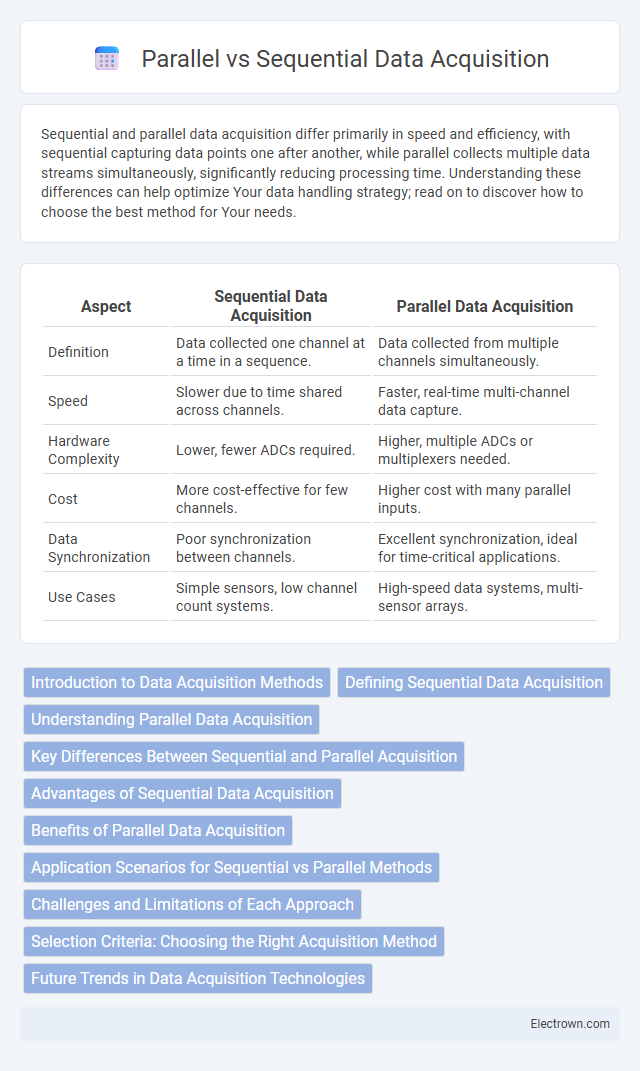Sequential and parallel data acquisition differ primarily in speed and efficiency, with sequential capturing data points one after another, while parallel collects multiple data streams simultaneously, significantly reducing processing time. Understanding these differences can help optimize Your data handling strategy; read on to discover how to choose the best method for Your needs.
Table of Comparison
| Aspect | Sequential Data Acquisition | Parallel Data Acquisition |
|---|---|---|
| Definition | Data collected one channel at a time in a sequence. | Data collected from multiple channels simultaneously. |
| Speed | Slower due to time shared across channels. | Faster, real-time multi-channel data capture. |
| Hardware Complexity | Lower, fewer ADCs required. | Higher, multiple ADCs or multiplexers needed. |
| Cost | More cost-effective for few channels. | Higher cost with many parallel inputs. |
| Data Synchronization | Poor synchronization between channels. | Excellent synchronization, ideal for time-critical applications. |
| Use Cases | Simple sensors, low channel count systems. | High-speed data systems, multi-sensor arrays. |
Introduction to Data Acquisition Methods
Sequential data acquisition captures information point-by-point in a linear, time-ordered manner, ideal for detailed analysis when sensor resources are limited. Parallel data acquisition collects multiple data channels simultaneously, significantly increasing speed and efficiency in multi-sensor environments. Choosing between sequential and parallel methods depends on application requirements such as timing precision, data volume, and system complexity.
Defining Sequential Data Acquisition
Sequential data acquisition involves collecting data points one after another in a specific, linear order, often used in time-series analysis or step-by-step measurement processes. This method ensures that each data point is dependent on the previous one or captures changes over time, making it ideal for monitoring gradual phenomena. Sequential acquisition reduces the complexity of data synchronization but can increase total collection time compared to parallel methods.
Understanding Parallel Data Acquisition
Parallel data acquisition simultaneously captures multiple signals using several analog-to-digital converters (ADCs), significantly increasing data throughput and reducing latency in measurement systems. This approach is ideal for applications requiring real-time processing of high-speed data streams, such as radar systems, medical imaging, and industrial automation. Understanding parallel data acquisition helps you optimize sensor networks and improve overall system performance by minimizing data bottlenecks and ensuring synchronized sampling.
Key Differences Between Sequential and Parallel Acquisition
Sequential data acquisition captures signals one at a time, leading to slower processing but simpler hardware requirements. Parallel data acquisition records multiple signals simultaneously, enabling faster data throughput and real-time analysis but necessitating more complex and costly equipment. The choice depends on application needs, balancing speed versus system complexity and cost.
Advantages of Sequential Data Acquisition
Sequential data acquisition offers enhanced precision by capturing data points in a controlled, time-ordered manner, which reduces measurement noise and increases reliability. It allows for detailed temporal analysis, making it ideal for processes requiring accurate tracking of changes over time. This method also simplifies hardware requirements compared to parallel acquisition, lowering system complexity and cost.
Benefits of Parallel Data Acquisition
Parallel data acquisition offers significant benefits including faster data collection rates and improved temporal resolution, enabling simultaneous monitoring of multiple sensors or channels. This method reduces latency and enhances real-time processing capabilities necessary in applications like medical imaging, communication systems, and industrial automation. Its ability to handle large volumes of data concurrently provides scalability and efficiency over sequential acquisition, which captures data one channel at a time.
Application Scenarios for Sequential vs Parallel Methods
Sequential data acquisition is ideal for applications requiring high precision and minimal crosstalk, such as medical imaging and high-resolution spectroscopy, where data integrity is crucial. Parallel data acquisition is best suited for real-time processing and high-throughput environments like telecommunications and radar systems, enabling faster data capture and reduced latency. You can choose between these methods based on the balance between speed requirements and the accuracy needed in your specific application scenario.
Challenges and Limitations of Each Approach
Sequential data acquisition faces challenges such as increased time consumption and potential data loss due to temporal changes between captures, limiting its efficiency for real-time applications. Parallel data acquisition, while faster, encounters constraints including higher system complexity, synchronization difficulties, and increased hardware costs. Your choice depends on balancing speed requirements against practical issues like cost, data integrity, and system design complexity.
Selection Criteria: Choosing the Right Acquisition Method
Choosing between sequential and parallel data acquisition depends on factors like speed requirements, system complexity, and cost constraints. Sequential acquisition suits applications needing high resolution with fewer channels, while parallel acquisition benefits high-speed data capture across multiple channels simultaneously. Your choice should align with the specific performance metrics and budget of your data collection system.
Future Trends in Data Acquisition Technologies
Future trends in data acquisition technologies emphasize the integration of parallel acquisition systems leveraging advanced multi-channel sensors and high-speed ADCs to handle massive data volumes efficiently. Innovations in AI-driven signal processing and edge computing enable real-time analysis and reduce latency in both sequential and parallel data acquisition methods. Enhanced wireless communication protocols and IoT integration further facilitate scalable, distributed data acquisition architectures for complex industrial and scientific applications.
Sequential vs Parallel Data Acquisition Infographic

 electrown.com
electrown.com